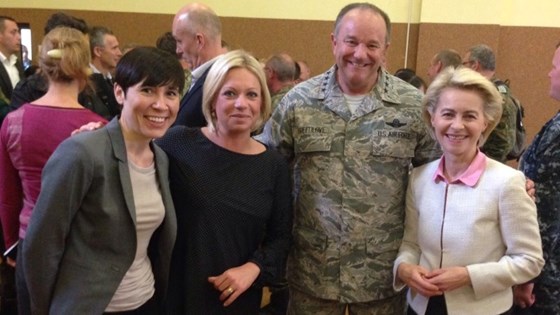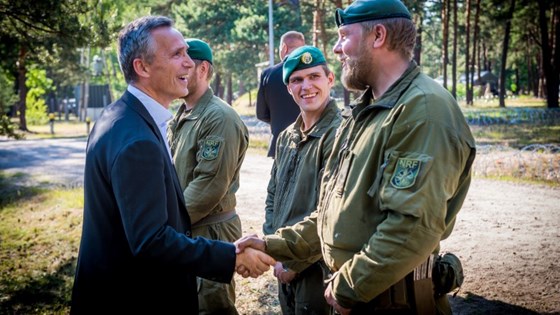Zagan training area, Poland:
Defence minister visits NATO rapid reaction exercise
Historical archive
Published under: Solberg's Government
Publisher: Ministry of Defence
Press release | No: 29/2015 | Date: 18/06/2015
Norwegian Minister of Defence Ine Eriksen Søreide today visited the NATO exercise Noble Jump and observed Norwegian and allied soldiers who are part of NATO’s new rapid reaction force.

Along with NATO Secretary General Jens Stoltenberg, Polish Deputy Prime Minister Tomasz Siemoniak and the defence ministers of Poland, Germany and the Netherlands, she and the Norwegian Chief of Defence attended a demonstration by the forces taking part in Noble Jump. The Norwegian defence minister met both Norwegian and allied soldiers. There were also discussions with fellow defence ministers about the importance of this exercise, and about how the participating countries including Poland itself (as the host nation for this part of Noble Jump) and the multinational headquarters are helping, through such training, to increase NATO’s readiness and defence capability.

At the NATO summit in Wales last September, the members of the alliance agreed on a Readiness Action Plan (RAP) containing a number of measures to improve defence readiness and capability. The alliance also decided to heighten its ambition level for the NATO Response Force (NRF).
“We agreed to establish a force that can react faster than the current NRF in crisis situations,” says Eriksen Søreide. “At the sharp end of this force is a new component, called the Very High Readiness Joint Task Force (VJTF). Germany, the Netherlands and Norway are cooperating on the pilot project to establish this high-readiness force. It’s been important for us to take part in developing it, both because we want to follow up concretely on the decision made in Wales and because it’s important to mould the concept so that smaller countries – like Norway – can provide substantial contributions.”
Today she got to see how far NATO has come in developing the concept.
Response to an altered security situation
“It is important to show that NATO is adapting to the changed security picture that we face in the north, in the east and in the south. Our actions make clear that we will protect our allies, but they also demonstrate the alliance’s ability and willingness to respond to new security challenges as needed,” says the defence minister, emphasising that NATO should now focus more on collective defence.
“Creating a ‘spearhead’, as we call it, within the NRF framework shows that we aim to strengthen the alliance’s deterrent capacity as well as NATO’s core task – collective defence,” Eriksen Søreide says. “We are also increasing our overall readiness and reaction capabilities, and taking important steps to increase NATO’s defensive strength. In this way we’re developing NATO’s overall security. At the same time NATO must have what it takes to solve the whole spectrum of major tasks. It’s therefore important to emphasise that we must continue to focus just as much attention on NATO’s depth and endurance.”
Eriksen Søreide adds: “Norway wants to be active in helping to strengthen NATO’s defence capability. Beyond addressing important tasks for the alliance in the north, Norway in the past year has contributed significantly to the alliance’s assurance measures in the Baltic and Poland. We will continue with this as long as necessary.”
Active ally
During exercise Noble Jump in Poland, a variety of elements are being practiced, such as force manoeuvring, host-country accommodation of allied soldiers, logistics and joint training for the nations taking part in VJTF development. Norway is contributing just under 200 Army soldiers.
“It is important for Norway to participate actively in allied exercises,” says Eriksen Søreide. “The best way to protect our security is to be prepared – and that’s why it is important to train. It is also important for Norway to show itself outside of Norway’s borders if we simultaneously expect an increase in the allied presence in Norway and surrounding areas.”
When NATO Secretary General Jens Stoltenberg was in Norway earlier in June, the Government announced that Norway would provide a total of six staff officers for NATO’s new command and control units in the Baltics and a multinational headquarters in Poland.
The Noble Jump exercise represents the first time these units have practiced their ability to receive and otherwise accommodate allied reinforcement forces in a collective defence framework.
“Secretary General Stoltenberg reiterated today that he is very glad Norway contributes so significantly to NATO,” says Eriksen Søreide. “The fact that we’ve also stepped forward to contribute to this new high-readiness force is clear evidence of our commitment and positive spirit.”
Bodes well
“We must be able to defend all the allies, and that’s why we train and exercise in this way. This is especially important now that we have seen a change in the threat and security situation. NATO is now undergoing a major restructuring that boosts our readiness and response capability. It was informative to see how NATO’s allies operate together,” the Norwegian defence minister says.
“Moving military forces on short notice is a complicated process that requires precise and proficient planning, continual adaptation and – not least – training. That explains why this exercise is so important. The soldiers have demonstrated how far they have come, and the exercise has provided valuable lessons for the further development of the VJTF. It’s also reassuring to see how the three countries – Germany, the Netherlands and Norway – are collaborating to help shape what will be the task force’s final form. This bodes well for the way ahead.”
Read also: http://nato.int/cps/en/natohq/news_120716.htm
Facts about the exercise:
Noble Jump is part of NATO’s Allied Shield series of exercises taking place in June 2015. A total of about 14,000 soldiers from 19 allied countries and three partner countries will participate in Allied Shield. Approximately 2,100 soldiers are taking part in the Noble Jump exercise in Zagan, Poland. The Norwegian force contribution consists primarily of a company with battalion leadership based in the Telemark Battalion. Noble Jump aims to test and refine the concept for the portion of the NATO Response Force (NRF) with the shortest deployment time: the Very High Readiness Joint Task Force (VJTF). In April 2015 a Noble Jump exercise of alert procedures was performed, with about 1,500 troops involved.